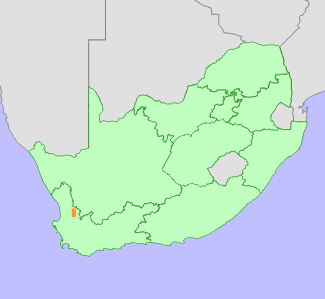|
Scientific Name | Hesperantha laxifolia Goldblatt & J.C.Manning |
Higher Classification | Monocotyledons |
Family | IRIDACEAE |
National Status |
Status and Criteria | Critically Rare |
Assessment Date | 2021/06/07 |
Assessor(s) | P. Goldblatt, J.C. Manning, D. van der Colff & T. Patel |
Justification | This is a range-restricted species with an extent of occurrence (EOO) of 18 km² and an area of occupancy (AOO) of 12 km². It is a habitat specialist known from ony two subpopulations. It is not threatened, and is therefore listed under the IUCN 3.1. criteria as Least Concern but is nationally recognised as Critically Rare. |
Distribution |
Endemism | South African endemic |
Provincial distribution | Western Cape |
Range | It is endemic to South Africa, and is known from a single, extended population in the Pakhuis Mountains of Western Cape. |
Habitat and Ecology |
Major system | Terrestrial |
Major habitats | Cederberg Sandstone Fynbos |
Description | It occurs in peaty and loamy sand on rocky, shaded, south-facing slopes. |
Threats |
| This species' habitat is well protected and it is not threatened. |
Population |
It is known from two locations recorded in 2012 and 2020. In 2020, only seven plants were seen.
|
Population trend | Stable |
Assessment History |
Taxon assessed |
Status and Criteria |
Citation/Red List version | | Hesperantha laxifolia Goldblatt & J.C.Manning | Critically Rare | 2015.1 | |
Bibliography |
Goldblatt, P. and Manning, J.C. 2013. New taxa of Hesperantha (Iridaceae: Crocoideae) from the southern African winter rainfall region and a review of the H. pilosa complex. Bothalia 43(2):145-151.
Goldblatt, P. and Manning, J.C. 2020. Iridaceae of southern Africa. Strelitzia 42. South African National Biodiversity Institute, Pretoria.
|
Citation |
| Goldblatt, P., Manning, J.C., van der Colff, D. & Patel, T. 2021. Hesperantha laxifolia Goldblatt & J.C.Manning. National Assessment: Red List of South African Plants version 2024.1. Accessed on 2025/10/26 |
 Comment on this assessment
Comment on this assessment


